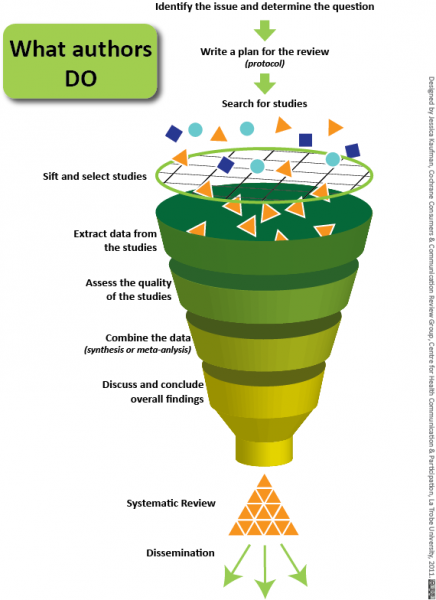Make an appointment with us if you need a librarian to help with your searches in the systematic review. You may also send us your search strategy sheet for checking before you start searching.
Many students are confused between literature review and systematic review. Here are the main differences between the two:
Source: Research World
 |
| Infographic from Cochrane |
Note that:
A systematic review requires a systematic search and systematic organization of literature. Both the selection criteria (inclusion and exclusion) of articles and the search strategy need to be explicitly stated in the review with a predefined structure.
There is no place for an "unsystematic" review in health and social care research. Review in an unsystematic way may introduce biased results and can lead to misleading conclusions.
To understand the structure of systematic reviews, the most efficient way is to look at other systematic reviews in your research area. This process also helps you avoid duplication of effort. Visit Find Systematic Reviews to learn where to find published systematic reviews and protocols.
Systematic review may or may not include a meta-analysis, which is a quantitative summary of the results.
Source: Evidence Synthesis Academy, Brown University
Here is a comparison of the two in detail:
| Systematic Review | Literature Review (or Narrative Review) | |
| Question | Research question is focusing on a single question. | Research question is not necessarily focusing on a single question, but may describe an overview. |
| Protocol | A peer review protocol or plan is included. | No protocol is included. |
| Background | Both provide summaries of the available literature on a topic. | |
| Objectives | Clear objectives are identified. | Objectives may or may not be identified. |
| Inclusion and exclusion criteria | Criteria is stated before the review is conducted. | Criteria is not specified. |
| Search strategy | Comprehensive search is conducted in a systematic way. | Strategy is not explicitly stated. |
| Process of selecting articles | Usually clear and explicit. | Not described in a literature review. |
| Process of evaluating articles | Comprehensive evaluation of study quality. | Evaluation of study quality may or may not be included. |
| Results and data synthesis | Clear summaries of studies based on high quality evidence. | Summary based on studies where the quality of articles may not be specified. May also be influenced by the reviewer’s theories, needs and beliefs. |
| Discussion | Written by an expert or group of experts with a detailed and well grounded knowledge of the issues. | |
| Method of undertaking review | Explicit and repeatable. | Not easily repeatable. |
| Reproduced from: Bettany-Saltikov, J, (2010). Learning how to undertake a systematic review: part 1. Nursing Standard. 24(50), 47-55. | ||
References: